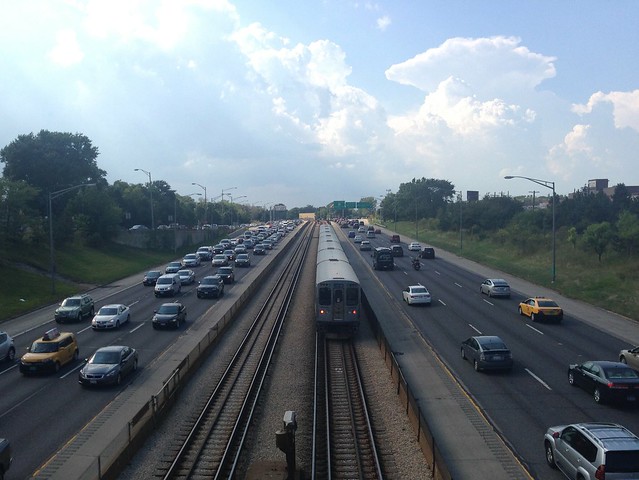Yesterday, a road construction lobbying group tricked many local publications into promoting their highway expansion agenda.
In what's become a common strategy for the road-building industry, the American Highway Users Alliance conducted a study called "Unclogging America's Arteries 2015," which reported that traffic congestion is really bad and, of course, adding more capacity for cars is the solution. Then they sent out a press release, counting on news outlets to spread the gospel. Since the report found that Chicago's Kennedy Expressway has the worst bottleneck in the nation, The Tribune, Sun-Times, CBS, and WGN all took the bait and largely regurgitated the press release.
Time Out Chicago, in particular, accepted AHUA's narrative hook, line, and sinker. Time Out went so far as to blame the CTA Blue Line, which runs down the median of the expressway, for standing in the way of fixing the traffic jam problem:
One immovable feature will force the road to be a bottleneck for the foreseeable future: the Blue Line. It prevents the Kennedy from expanding (the same applies for the Eisenhower Expressway on the West Side), which is a painful result of short-sighted 20th Century urban planning.
Time Out has it backwards. The real myopic urban planning was the decision to bulldoze hundreds of revenue-producing properties, displacing countless residents and businesses, to build the highway. Far from being foolish, the late-Sixties decision by planners and politicians to include a 55 mph rapid transit line in the median of the Kennedy was a savvy use of resources, since it was much cheaper than building a separate subway.
Granted, rapid transit is most useful when stops are located in the center of dense, walkable retail districts, and the middle of a highway isn't the most pleasant place to wait for a train. But it's fortunate that the powers that be chose to build new 'L' lines in the medians of the Kennedy, the Eisenhower, and the Dan Ryan, rather than not build them at all.
In the modern era, it's short-sighted to think we can solve the traffic jam problem on urban highways by adding capacity, even though the road lobbyists would like us to believe otherwise. Time Out argued that the $420 million Jane Byrne Interchange expansion project and the $3.4 billion Elgin-O'Hare Expressway extension "will go a long way in reducing traffic on the North Side highway."
On the contrary, highway expansion projects don't reduce congestion in the long run. They provide temporary relief, but studies show that the extra capacity tends to encourage more car trips, a phenomenon known as induced demand, so the new lanes are soon filled with vehicles again.
The Blue Line deserves more far credit for fighting congestion than those costly road expansion projects because it provides commuters with an alternative to driving to and from downtown. That's good for reducing traffic jams, good for the environment, and much healthier than a long, daily car commute.
Update 11/25/15 10:00 a.m.: After we pointed out the absurdity of the original Time Out post, they added the following text:
The Blue Line is a better option than a car for people traveling across the city. Chicago is one of three cities across the country where public transit to the airport is faster than driving. So if you can't handle any more traffic on the Kennedy, consider trading in your car keys for a Ventra card.
Thanks to Streetsblog Chicago reader "objectathand" for alerting us.
![]()
Did you appreciate this post? Streetsblog Chicago is currently funded until April 2016. Consider making a donation through our PublicGood site to help ensure we can continue to publish next year.





